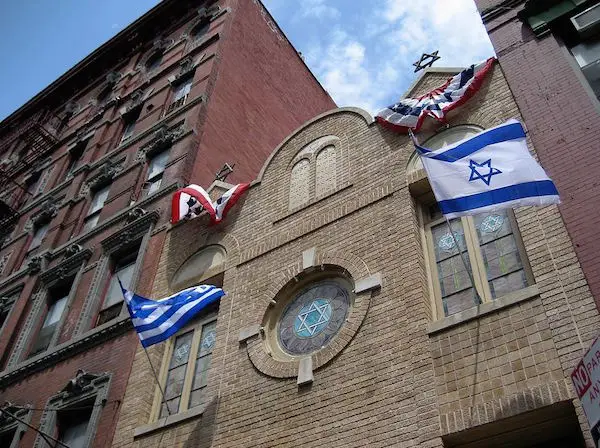Whether you are interested in history, Judaism, architecture, or even none of the above, there is a lot to enjoy at three old synagogues on Manhattan’s Lower East Side, the most famous immigrant district in a city renowned for its immigrant history. All three can be visited in a few hours as distances between them are small.
The Bialystoker Synagogue, 7-11 Willett Street/Bialystoker Place, began in 1826 as the Willett Street Methodist Episcopal Church. Evidence—a door off the balcony purportedly used to conceal a hiding place for escaped slaves suggests that in the mid-19th century the church was a stop on the Underground Railroad. The synagogue was among New York City’s first landmarks, designated in 1966, and listed on the National Register of Historic Places in 1972.
By 1905, New York City's congregation of Jews from Bialystok, then a part of the Russian Empire and now located in Poland, had grown large enough to purchase the building and convert it into a synagogue. While the exterior is spare, the interior has lavish liturgical furnishings, stained glass dating from 1905 and a ceiling painted with signs of the zodiac.
Besides services there are classes, lectures and a gift shop. bialystoker.org

Nestled in what is now considered part of Chinatown, Kehila Kedosha Janina (KKJ), 280 Broome Street, is the only remaining Romaniote (ancient Greek) synagogue in the Western Hemisphere. The congregation was founded by immigrant Jews who came to New York from Ioannina, Greece in 1902-1924. Members of today’s congregation are descendants of the original founders, who, according to legend, escaped from a Roman slave ship and swam ashore.
The small, three story brick building was completed in 1927 and restored in 2002-2003. There is a museum on the balcony level illustrating the history, traditions, customs, and dress of the congregation and Romaniote Jews in general. The museum, open Sundays from 11 am -4 pm, also includes a library, art gallery and the first Holocaust Memorial to Greek Jews in America. KKJ hosts a variety of public lectures and film screenings on Romaniote, Sephardic, and Jewish topics. kkjsm.org

The Stanton Street Shul, 180 Stanton Street, is a historic, intimate, and vibrant modern Orthodox congregation serving the diverse Jewish population of Lower Manhattan. Constructed in 1913 at the height of Jewish immigration to the Lower East Side, the synagogue housed a congregation founded in1894 by immigrant Jews from the town of Brzezany, Galicia, Poland (now in the Ukraine).
The building was designed by neighborhood architect Louis A. Sheinart and constructed in 1913 by combining two adjacent tenement buildings into one structure. What was formerly Congregation B'nai Joseph Anshe Brzezan, is one of the few, surviving, early 20th century "tenement synagogues" in the area. The exterior has a Classical façade; inside, the sanctuary is a time capsule with a pressed metal ceiling, nickel-plated fluorescent light fixtures, original marble memorial plaques and rare surviving Jewish decorative painting encircling the walls: a cycle of zodiac murals (“mazoles” in Yiddish), above a faux-marbleized wainscoat.
The shul holds hosts musical events of many types including klezmer, classical and opera, monthly community dinners, a young professionals dinner, a talent show, and other programs. stantonstshul.com







